Column: Battling the honeybee pandemic
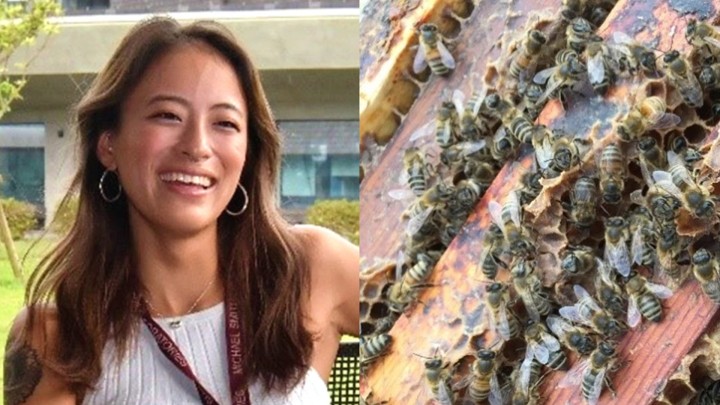
The latest OIST column in the Asahi Shimbun GLOBE+ is out now! This month, OIST science writer, Dani Ellenby, spoke to PhD student Nonno Hasegawa about her research into the honeybee's greatest threat - the Varroa mite. The article is in Japanese, but the original English version can be read below.
Battling the honeybee pandemic
Honeybees are unique and fascinating creatures, famed for their complex social system and enviable work ethic. But in recent decades, honeybees have been generating a buzz for less desirable reasons, as their population rapidly crashes.
And it’s a massive problem – not only for the bees, but also for our own society.
Honeybees make an enormous contribution to our economy, producing resources like honey and royal jelly, but more importantly, through global pollination services. These days, experts believe that honeybees pollinate about a third of the world’s crops, and along with other pollinators, help support the global production of around US$170 billion worth of crops – a vast sum that could soon be in jeopardy.
In the US alone, a country that relies heavily on managed honeybee colonies for agriculture, the number of honeybee colonies has fallen from 5.9 million in 1947 to only 2.44 million in 2008.

But the reasons why honeybee colonies are collapsing remain poorly understood.
“It’s almost certainly due to a whole host of different factors, including pesticides, climate change and habitat loss. Two major factors that I’m interested in are parasites and pathogens,” said Nonno Hasegawa, a second year PhD student at the Okinawa Institute of Science and Technology Graduate University (OIST).

Although born and raised in Japan – in the surfing hometown of Chigasaki, Kanagawa – Nonno was first introduced to honeybee research in Canada. There, she carried out an internship at the University of British Columbia, as part of her Bachelor’s in Biochemistry at the University of Guelph, Ontario.
“We were trying to find a way to tackle the spread of the bacterial disease, American foulbrood,” said Nonno. “What’s scary about this disease is, once a hive is infected, the only way to treat it is to burn the whole hive. At the moment, artificial antibiotics are used to prevent a hive from becoming infected, but due to rising concern with antibiotic resistance and human health, we were trying to find plant extracts that worked instead.”
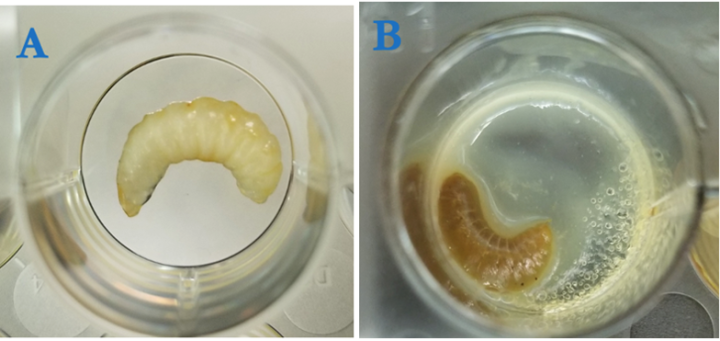
“And so my internship is when I first became obsessed with honeybees,” she added, with a laugh. “They’re just so fuzzy, and really gentle – you don’t need to worry about being stung at all. And when they snuggle up to flowers to collect nectar and pollen, I think they look so cute!”
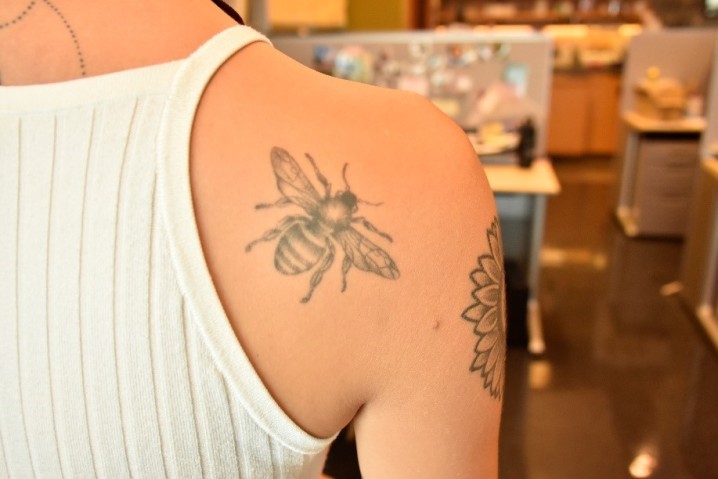
It was through her love for honeybees that Nonno first became interested in OIST, which had a research unit that studied parasites and pathogens of honeybees. After a rigorous selection procedure, (OIST only takes about 60 students each year), Nonno joined the Evolution and Ecology Unit for her first PhD research rotation project. She focused on a parasitic mite that in recent decades has been spreading uncontrollably from hive to hive, jumping across borders and oceans to reach almost every continent.
This parasite, aptly named Varroa destructor, doesn’t look too threatening – it’s only the size of a pinhead – but it’s one of the leading causes of the honeybee’s global decline. Once it has invaded the hive, it attaches itself to developing larvae, leaching fat from the larvae’s body and weakening it.

Like many pests and pathogens, the Varroa mite first started causing problems when it jumped host species, moving from the Asian honeybee, Apis cerana, to the European honeybee, Apis mellifera, in the mid-20th century, when European honeybees were brought into Asia for commerical beekeeping.
Over the following decades, a full-blown mite pandemic has devastated populations in North America, Europe, and more recently New Zealand. Australia now remains the only Varroa-free haven for honeybees.
Japan too is feeling the strain. An estimated 99% of Japanese commercial beekeepers use European honeybees, as these bees produce more honey and are less likely to abandon their nest than their Japanese counterparts. Between 2008 to 2011, tens of thousands of European honeybee colonies in Japan died, according to the Japan Beekeeping Association, at least in part due to the mite.
But although the mites weaken the bee larvae, it’s the viruses that the mites carry and transmit to the bee that have the most devasting impact. These viruses can weaken the larvae’s immune system, prevent proper development and cause cognitive impairments.
“There are some really nasty viruses, like the deformed wing virus. This is the biggest killer, as the infected honeybees aren’t able to fly,” Nonno explained to me. “So it’s really important for beekeepers to understand what viruses are present in their colonies.”
But practically speaking, figuring out which viruses a mite carries presents a massive challenge. Beekeepers can be trained to spot a mite infestation, but the best way to identify a virus is to read its genetic material, either RNA or DNA. That requires a sequencing machine – a piece of equipment that’s not typically within a beekeeper’s arsenal.
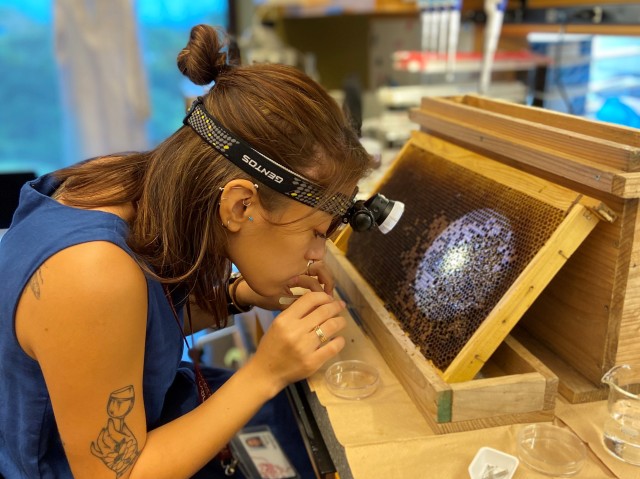
“Beekeepers in the field need to be able to send mite samples back to a research lab for sequencing. My task was to try and find a way of storing the mites during transport that keeps the RNA and DNA within each mite preserved well enough to do that,” said Nonno.
For her project, Nonno collected mites from honeybee colonies and then submerged them in different solutions. After 21 days, she collected DNA and RNA from the mite, included viral RNA, and sequenced it, to see how well it had been preserved.
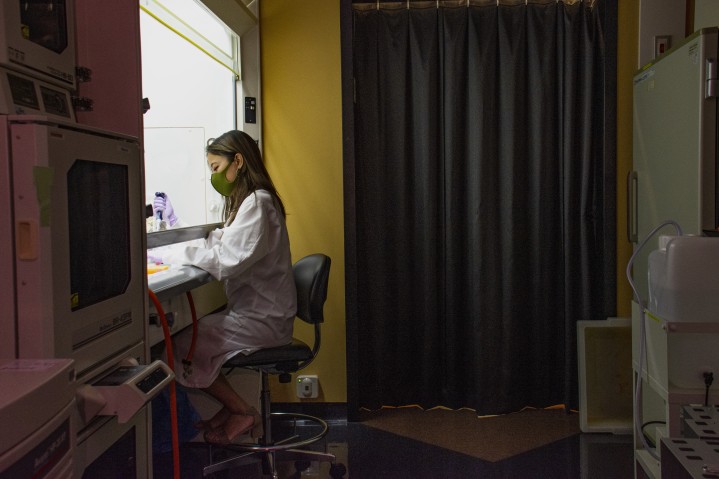
She found that ethanol worked the best for keeping the genetic material of both the mite and the viruses it harbored intact.
“It’s cheap, easily available in shops, and amazingly, it still preserved the DNA and RNA at room temperature, which makes it much easier to transport the mites to a research lab for testing!”

Nonno’s research was published earlier this year in the scientific journal, BMC Genomics – a major accomplishment for such a short-term project.
“To have a published paper this early on in my PhD feels so cool!” said Nonno. “It was really tough and demanding to write it while still doing rotations with other units – my supervisor really pushed me to do the best I could. But it was worth it in the end.”
“I hope that in the future, my work can really help in the fight against the Varroa mite,” she added.
But, Nonno emphasized, while a great deal of research is being carried out to protect the commercially managed honeybee population, the decline of other species of wild bees, which are also important pollinators, is of even bigger concern.
“There are over 20,000 different species wild bees, some of which are native to just one area or pollinate just one type of plant and these species also need our help. We can all play a part in protecting them – even through something as simple and small as planting native flowers.”














